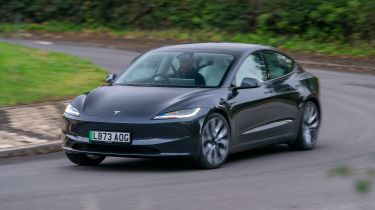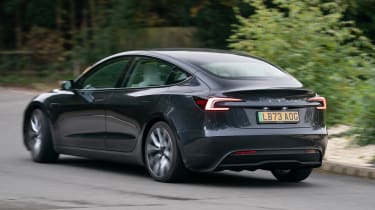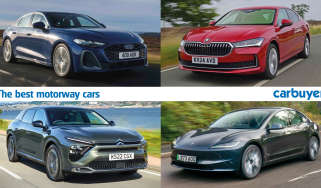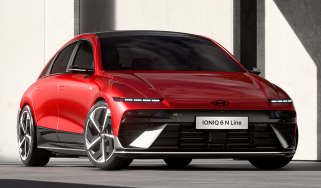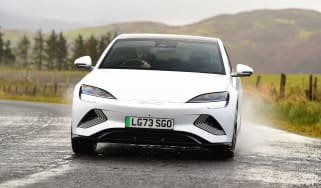Tesla Model 3 review - Electric motor, drive & performance
"The Tesla Model 3 is capable of outrunning most other cars, but lacks feedback"
We’ve now tested the facelifted Model 3 Standard Range and Performance on British roads. Faster versions continue to offer Teslas’ now-legendary ability to push you back into your seat with a flex of your right foot. This isn't just the Model 3's party piece, it also makes for relaxed progress with the knowledge you can easily overtake slower traffic when necessary.
With large 18-inch (or optional 19- and 20-inch) wheels fitted, the Model 3's ride is definitely on the firm side, but it's also not ruinously uncomfortable on either motorways or back roads, with a more forgiving ride than the Polestar 2. It has also improved with the facelift, so if you’ve driven an earlier Model 3 and found it too stiff, it’s worth another go.
There’s plentiful grip, so the Model 3 is certainly a car you can trust in corners, but sadly, there’s little steering feedback to savour, even in Sport mode which adds some weight to the steering. If you spend a lot of time on A and B roads, the BMW i4 offers a bit more sensation from behind the wheel.
Pre-facelift Performance cars were plenty quick enough, but this time Tesla has put more emphasis on driving feel and chassis setup, adding adaptive dampers, thicker anti-roll bars and larger brakes. We prefer the steering feel on the Model 3 Performance compared to lesser versions because it’s a little weightier and more consistent. There’s a new ‘Track’ mode on the Model 3 Performance, which drastically changes how the car puts power down – for example you can now adjust how much power goes to the rear wheels, how much stability control intervention there is and the level of regenerative braking. That last parameter is hardly a first for an EV, but it is for a Tesla. Another upgrade is adaptive suspension, so now there’s a bigger difference in feel between driving modes, and the chassis feels a lot more sophisticated as a result.
More reviews
In-depth reviews
Thanks to these additions, Tesla has managed to make the Model 3 Performance more engaging and exciting than ever before, but unfortunately it still doesn’t quite match the BMW M3 in this area. The Model 3 doesn’t inspire as much confidence as the BMW, and the braking force is hard to modulate – we found the switch between regenerative and mechanical braking hard to predict, while many other EV manufacturers have managed to make this transition much smoother.
0-62mph and top speed
Thanks to their instant torque and a single forward gear, every Tesla Model 3 is fast off the mark. Even the entry-level base Model 3 with rear-wheel drive can sprint from 0-62mph in 5.8 seconds, making it as quick off the line as a BMW 330e. In real-world driving, the entry-level model offers substantial amounts of acceleration on demand, making easy work of overtaking and getting up to speed on motorways. Because it's around 200kg lighter than dual motor versions, the entry-level Model 3 also feels quite agile, making the most of its low centre of gravity.
However, the real fun begins with the dual-motor Long Range All-Wheel Drive model because it has an electric motor over both axles for truly gobsmacking acceleration. It spears from 0-60mph in 4.2 seconds and its ability to tear away from the line makes it feel even faster. While it felt like the fastest model in our lineup against other electric company cars, we found the BMW i4 to have the edge in terms of overall driving feel, so if that’s a priority its worth taking a test drive in both.
The facelifted Model 3 Performance can get from zero to 60mph in 2.9 seconds – though that’s with a rollout time subtracted, so in reality from a standstill we’d expect 0-62mph to take around three-and-a-bit seconds. That’s humbling not just everything in the executive class, but most sports cars, too.
Of course, you don't necessarily have to do all of the driving. In the UK, the Model 3 comes with Autopilot as standard, with adaptive cruise control and lane-keeping. You still have to rest a hand on the steering wheel, but the Model 3 will accelerate, brake and steer while monitoring the vehicles around you so long as the road is clearly marked. Indicate left or right and Autopilot will also judge if it's safe to change lanes and complete the manoeuvre for you. It's regularly improved thanks to wireless internet updates.
It’s a shame there’s not more adjustment of the regenerative braking, though. While rivals like the Hyundai Ioniq 6 have paddles to quickly increase the regen strength depending on the driving conditions or your personal preference, the Model 3 only has one setting, and it’s pretty strong for ‘one-pedal driving’ that brings you to a halt if you ease off the throttle completely. It works well around town, but isn’t as well suited to faster roads.
| Model | Power | 0-62mph | Top speed |
| Standard Range | 242bhp | 5.8s | 125mph |
| Long Range Rear-Wheel Drive | 315bhp | 4.9s | 125mph |
| Long Range All-Wheel Drive | 346bhp | 4.2s | 125mph |
| Performance | 453bhp | 2.9s (with rollout) | 163mph |
